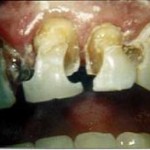
decayed teeth
Have a problem with tooth decay? Tooth decay or otherwise called caries has been a vast predicament that affects most dentate people. According to the United States Surgeon General’s report, caries is stated to be the most common chronic childhood disease of children aged 5 to 17 years and is five times more common than asthma and seven times more common than hay fever.
How does our tooth get caries?
Tooth decay is a demineralization process of hard tissues in our mouth that are contributed by four major factors namely bacterial microorganism, sugar (carbohydrates), tooth surface and time. Without this four factors decay would not occur. A community of haphazard collection of bacteria on your tooth is called plaque.
This bio film of plaque is capable of fermenting carbohydrate substrates (sugars like sucrose and glucose) and producing acid causing the plaque pH to fall below 5 within 1-3 minutes. Repeated falls in pH results in demineralisation of tooth surface and leads to carious lesion formed.
Is it possible? Is reversal a myth or fact?
Yes, the good news is it is possible to modify the carious process. Most lesions could be arrested and prevented from worsening. However, to achieve reversal of tooth decay the remineralisation of tooth structure need to happen. As long as the surface of tooth was not damaged, the initial decay area (enamel) will remineralize and would not need a filling. Hence, most early decay could be reversed. Bad news is, deeper decay involving dentine most likely needs a restorative procedure with the dentist.
When decay reaches the dentine, the tooth will have a response to recede the sensitive pulp which contains numerous blood vessels and nerves by moving it inwards with new layers of dentine deposited. However, if the surface enamel is breached, invasion of plaque and substrate debris will further aggravate decay.
As such, at this situation you will begin to feel sensitivity to cold, heat, acid or during chewing. You will realize once it hurts it is deemed ‘too late’ as bacteria has already works its way through dentine and pulp causing inflammation of pulp. As the saying goes, “teeth don’t die a natural death; it’s your habits that killed themâ€
How to reverse tooth decay?
Enforce your attitude to reverse the process by methods as follows:
1. Fluoride therapy
Researches proven that supplement of fluoride prevent and even reverse tooth decay. It inhibits demineralization of tooth surfaces and halt bacterial enzymes. Seafood (i.e. canned fish) and tea is the principal dietary sources of this ion. As a reversal measure done at home, we could use fluoridated toothpaste, fluoride mouthwash and even drinking naturally fluoridated water supply to counter decay.
You could even consult a dentist for sodium fluoride varnish or gel application if most of your teeth are decay prone, or your child has rampant caries. However, bear in mind you should not seek this option for children under the age of 6 years.
2. Good Oral Hygiene
Maintenance of good oral health includes removal of plaque by proper tooth brushing, flossing and mouth rinses. Visit a dentist every 6 months to have scaling procedure done to eliminate plaque. Chlorhexidine mouthwash has been shown to have good plaque inhibiting properties as it is antibacterial. Note that staining and bitter taste could ensue with its usage.
3. Diet
As the rule of thumb, reduce sugary consumption by the frequency and amount. This golden rule is a great solution to halt decay! If you do not feed the bacteria with substrate for metabolism, decay may be a standstill altogether. Reduce sticky, sugary carbohydrates, but take in ample complex carbohydrates. Also consume food high in fat soluble vitamins (vitamin A, D,E, K).Use nutritive sugar substitutes like sorbitol, mannitol, xylitol and isomalt. Chocholate with less sugar additives also prevent caries.
4. Saliva flow stimulation
Saliva acts as a buffering system that neutralizes pH falls when bacteria plaque metabolizes sugar. Example of saliva stimulants are
- Sugar free chewing gum, particularly containing xylitol. Xylitol proves to reverse decay by preventing bacterial binding and disturbance of its metabolic process.
- Saliva stimulating tablet, increases saliva secretion through stimulation of taste buds.
- Lozenges
- Drugs like pilocarpine hydrochloride which is recommended to patients with chronic dry mouth.
5. Calcium intake
Calcium is needed to strengthen tooth and alveolar bone of jaw thus daily consumption of it is important.
6. Green tea
Green tea has abundant antioxidants that prevent plaque and are equipped with bactericidal properties. Most importantly it contains fluoride that reverses decay. It also helps in bad breath reduction.
7. Use a straw
Most acidic beverages like soft drinks, soda, and fruit juices do erode enamel. Straw will limit contact of the drinks from our teeth and protects enamel surface. Weakening of tooth structure could lead to decay.
Why is it beneficial to prevent it from the start?
Prevention is always better than cure. Without any initial decay, our tooth would not have to undergo a reversal process. Hence, develop good hygiene habits and work that plaque off! Also, your dentist may recommend fissure sealants in areas where a risk of caries is foreseen.
When to seek a professional?
A dentist consultation is always necessary to catch and arrest decay before it reaches the point of no return or when reversal is not an option. If you suspect decay by the change of colour of tooth structure (darkened brown), a cavity formed or pain experienced, it is time to pay the professionals a visit. Schedule an appointment now!



